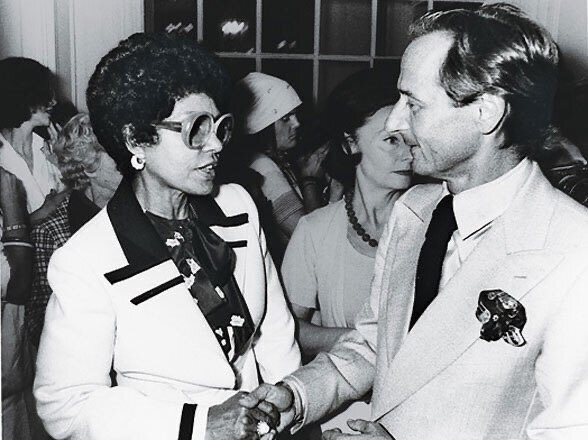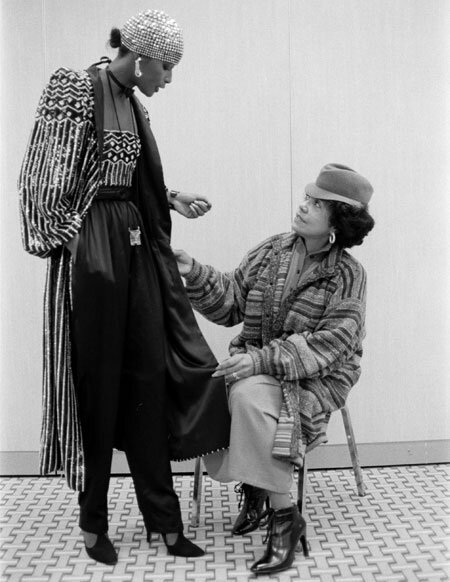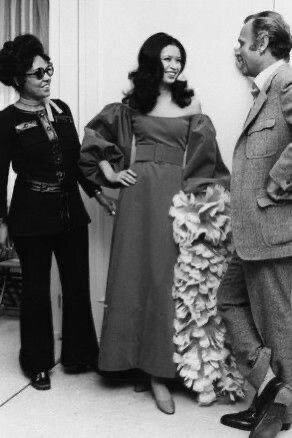WRITTEN BY SHARRA GREENE
Eunice sitting front row at the Bill Blass show, circa ‘71. This photo says so much.
Self quarantining has me watching and rewatching fashion documentaries both old and relatively new. As I’m revisiting some of my favs (House of Z, The September Issue, In Vogue: The Editor’s Eye, etc.) I couldn’t help but notice how many of the most influential blacks in fashion do not have a highlight reel for me to indulge in during this time. (Disappointed? Yes. Surprised? Not at all.) One in particular came to mind as it was so painfully obvious that she of all people is way overdue for a fashion film covering her life and legacy. Let me find out I gotta switch career paths real quick just to make sure it’s done and done right! (I’m probably bluffing so somebody in the film industry, please get on it ASAP. It’s so necessary!)
If you listen to my podcast or follow this blog, I’m pretty sure you’ve heard me rant about the iconic Eunice Walker Johnson at least once before. I’m obsessed. She’s been my blueprint and one of my biggest inspirations when it comes to being proactive with my goals in fashion and not waiting for someone else to hand me an opportunity. If you’ve been living under a rock (or are just uninformed because not enough fashion platforms speak on her impact) let me school you real quick.
Model Pat Cleveland at an annual Ebony Fashion Fair showcase in Versace couture.
Seeking to raise money for local charities in the black community, Eunice Walker started the Ebony Fashion Fair back in 1958, an exhibition, named after the magazine that she and her husband John H. Johnson founded as part of their growing publishing company (yes, I’m referring to THE Ebony Magazine). The showcase brought high fashion and haute couture to a new audience, a black one. Walker’s exhibit ended up raising over 50 million dollars for charity along with introducing countless black models, artists, and coordinators to an industry that was typically discriminatory and closed off to them, by hiring and casting them in the annual production.
Eunice and some of her models at the 33rd annual Fashion Fair, themed “Freedom Explosion”.
Throughout the 60’s and 70’s, much of Eunice’s time was spent curating the show and networking to make the necessary connections needed to make her showcase great year after year. She spent a lot of time collaborating with emerging designers in the black community as well as traveling to top mainstream designers’ shows, even sitting front row at many of them. You can imagine that this created friction in the industry, as Eunice and her team often struggled with getting into the shows that they had so diligently earned the right to attend, due to the racism and nepotism that plagues the fashion industry. But numbers don’t lie. The monetary success of Ebony which, keep in mind, Eunice’s husband John was the founder of, often played a role in making the gatekeepers budge. Walker would bring back pieces from some of the most sought after designers to feature in her showcase, which had a strategic theme each year.
An exhibit of some archived pieces from the showcase over the years.
In addition to her success in the fashion space, Eunice essentially was the Fenty Beauty before Fenty Beauty. She founded Fashion Fair Cosmetics, THE FIRST beauty line made specifically for women of color. The high demand of quality makeup products for darker skin tones made her an innovator in the cosmetic industry and forced other competing companies to look at the quality and availability of makeup that they provided for black women, or lack thereof.
Enough said. Run my idol her documentary ASAP. Maybe it’s just not on my radar. If you know any cool documentaries that cover Eunice Walker Johnson, beyond the 5 minute clips found here and there on the internet, please send them my way! Link them below! See more of my fave images of Eunice in her element in the gallery above.











